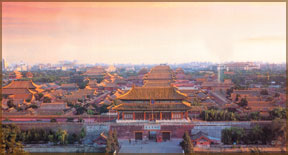
Getting lost in 'Forbidden City'
BY ANJANA Gamage
AS I climbed the "Great Wall" in China recently, I felt great to have
obtained another rare opportunity to see the world's largest palace
complex in China during my stay. Unlike in the past there is no king to
rule the palace and no servants around.

Nowadays, the Forbidden City, or the Palace Museum is open to
tourists from home and abroad. Thousands and thousands of foreign and
local tourists wearing colourful hats, caps and some of them carrying
umbrellas visit this palace daily.
Lying at the centre of Beijing, the Forbidden City, called Gu Gong,
in Chinese, was the imperial palace during the Ming and Qing dynasties.
Now known as the 'Palace Museum', it is to the north of Tiananmen
Square.
Rectangular in shape, it is the world's largest palace complex which
covers 74 hectares. Listed by UNESCO as a World Cultural Heritage Site
in 1987, the Palace Museum is now one of the most popular tourist
attractions worldwide.
Surrounded by a six meter deep moat and a ten meter high wall there
are 9,999 half bays of palaces and halls within the Imperial Palace. The
wall has a gate on each side. Opposite the Tiananmen Gate, to the north
is the Gate of Devine Might (Shenwumen), which faces Jingshan Park.
The distance between these two gates is 960 meters, while the
distance between the gates in the east and west walls is 750 meters.
There are unique and delicately structured towers on each of the four
corners of the curtain wall.
These afford views over both the palace and the city outside.
Splendid painted decoration on these royal architectural wonders, the
grand and deluxe halls, with their surprisingly magnificent treasures
will certainly satisfy "modern civilians".
The Forbidden City is divided into two parts. The southern section,
or the Outer Court was where the emperor exercised his supreme power
over the nation. The northern section, or the Inner Court was where he
lived with his royal family.
Until 1924 when the last emperor of China was driven from the Inner
Court, fourteen emperors of the Ming dynasty and ten emperors of the
Qing dynasty had reigned here.
Having been the imperial palace for some five centuries, it houses
numerous rare treasures and curiosities. Construction of the palace
complex began in 1407, the 5th year of the Yongle reign of the third
emperor of the Ming dynasty. It was completed fourteen years later in
1420.
It was said that a million workers including one hundred thousand
artisans were driven into the long-term hard labour. Stone needed was
quarried from Fangshan, a suburb of Beijing.
It was said a well was dug every fifty meters along the road in order
to pour water onto the road in winter to slide huge stones on ice into
the city. Huge amounts of timber and other materials were freighted from
faraway provinces.
Ancient Chinese people displayed their very considerable skills in
building the Forbidden City. Take the grand red city wall for example.
It has an 8.6 meters wide base reducing to 6.66 meters wide at the top.
The angular shape of the wall totally frustrates attempts to climb
it. The bricks were made from white lime and glutinous rice while the
cement is made from glutinous rice and egg whites. These incredible
materials make the wall extraordinarily strong.
Since yellow is the symbol of the royal family, it is the dominant
colour in the Forbidden City. Roofs are built with yellow glazed tiles;
decorations in the palace are painted yellow; even the bricks on the
ground are made yellow by a special process.
However, there is one exception. Wenyuange, the royal library, has a
black roof. The reason is that it was believed black represented water
then and could extinguish fire.
As you know, the Forbidden City contains 9,999 buildings, so it is
easy to get lost unless one is familiar with the Chinese architectural
layout, although it is definitely symmetrical. For me the visit was an
experience of a lost in a Forbidden city! |

